clarinet
All scores that include a part for at least one clarinet.
-
Hatton - Wreck of the Hesperus - Theatre Orchestra
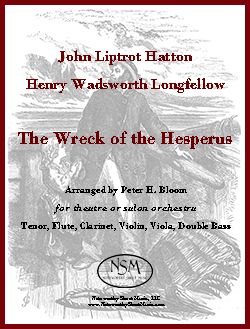 The Wreck of the Hesperus, by J. L. Hatton & H. W. Longfellow
The Wreck of the Hesperus, by J. L. Hatton & H. W. LongfellowArranged for theatre or salon orchestra by Peter H. Bloom
Tenor, Flute, Clarinet, Violin, Viola, & Double Bass Parts, and Mini-Score ― PDF $19.98
The "dramatic scena" was an especially popular entertainment at its zenith in the mid-nineteenth century throughout the English speaking world. John Liptrot Hatton's setting of Longfellow's Wreck of the Hesperus is the very model of the dramatic scena at its finest, and a magnificent showcase for an heroic tenor. Longfellow's ballad recounts a chilling tale loosely based on conflated reports of two New England shipwrecks that occurred during a single devastating blizzard in 1839. This arrangement of Wreck of the Hesperus for theatre or salon orchestra was made for the now retired D.C. Hall's New Concert and Quadrille Band of Boston, and their extraordinary tenor Kevin McDermott. It can be heard on the Hall's Band's CD recording "Grand Concert," winner of the Noah Greenberg Award of the American Musicological Society. (excerpted from Peter H. Bloom's © foreword)
Click the mp3 icon to listen to an audio clip of Wreck of the Hesperus from the Hall's Band CD recording Grand Concert!.

The D.C. Hall's Grand Concert! CD is available from NSM - click to access the page.
Tenor part, 4 pages; Flute part, 2 pages; Bb Clarinet part, 2 pages; Violin part, 2 pages; Viola part, 2 pages; Double bass part, 2 pages; Mini-Score, 8 pages; Total, 26 pages.
Preview
===========================================
We also offer a professionally-printed hard copy edition of The Wreck of the Hesperus for $29.97 plus a $5.95 shipping and handling fee to addresses in the USA. Please use the Contact Us form to let us know which hard copy publication(s) you would like to purchase, along with your email contact information and USPS mailing address. We will then send you a PayPal invoice for the sale and, once we receive notice from PayPal that you have paid for the item(s), we will ship your music to the address provided.
-
Haydn - Early Sonatas - arr. as Wind Duos
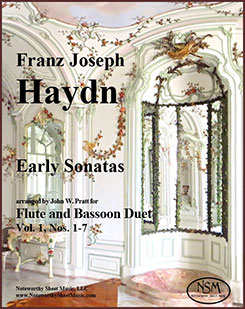 Early Sonatas, by Franz Joseph Haydn
Early Sonatas, by Franz Joseph HaydnArranged as Woodwind Duets by John W. Pratt (originally for keyboard)
Even the earliest of Franz Joseph Haydn’s keyboard sonatas have great rhythmic variety and vitality, and are delightful when played with verve. They are mostly in two voices, and even where not, their early classical harmonies are easily conveyed by two instruments. They incorporate few pianistic effects and lie comfortably within range for flute or oboe and bassoon or clarinet, and thus make natural woodwind duets of lively, interesting music. All these editions include a score and parts. Those wishing to consult the keyboard editions of the Haydn sonatas, from which Mr. Pratt created his arrangements, can find them at imslp.org. (Adapted from J. W. Pratt’s preface to the edition.)
Cover image “Decorations of the Sala Terrena, Eszterházy Palace in Fertőd, Hungary“ by Monyesz, Creative Commons Attribution-Share Alike 3.0 Unported license.
--------------------------------------------------------------------------------
►Early Haydn Sonatas arranged by John W. Pratt as Duets for Flute and Bassoon, Vol. 1, Nos. 1-7Score, 26 pages; Flute part, 14 pages; Bassoon part, 11 pages; Total, 54 pages; PDF $14.75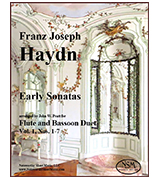 This edition includes seven of Haydn's early keyboard sonatas arranged as duets for flute and bassoon. John Pratt's creation of these duets was inspired by a desire to offer two of his music colleagues some new music to enjoy, as they had exhausted their available flute and bassoon duo repertoire. These duets work nicely for winds and are fun to play. For a sense of how they sound when played by flute and bassoon, click below to listen to a computer-generated audio excerpt: the first 45” of the recording come from the Andante of Sonata 5 (Hob. XVI:11), followed by 25” of the Sonata 6 (Hob. XVI:10) Presto. Alternatively, the flute part can be played on oboe, making these sonata arrangements nicely amenable to oboe and bassoon duos as well.
This edition includes seven of Haydn's early keyboard sonatas arranged as duets for flute and bassoon. John Pratt's creation of these duets was inspired by a desire to offer two of his music colleagues some new music to enjoy, as they had exhausted their available flute and bassoon duo repertoire. These duets work nicely for winds and are fun to play. For a sense of how they sound when played by flute and bassoon, click below to listen to a computer-generated audio excerpt: the first 45” of the recording come from the Andante of Sonata 5 (Hob. XVI:11), followed by 25” of the Sonata 6 (Hob. XVI:10) Presto. Alternatively, the flute part can be played on oboe, making these sonata arrangements nicely amenable to oboe and bassoon duos as well.
Preview: Vol.1, Nos. 1-7, Flute and Bassoon--------------------------------------------------------------------------------
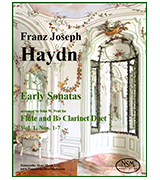 ►Early Haydn Sonatas arranged by John W. Pratt as Duets for Flute and B-flatClarinet, Vol. 1, Nos. 1-7
Please see the description above for Volume 1 of Haydn’s early keyboard sonatas arranged as duets for flute and bassoon. Our flute and clarinet edition of Vol. 1 contains the same seven sonatas, here arranged for flute (or oboe) and B-flat clarinet. Click to listen to a computer-generated audio clip of two excerpts: the first 27” of the recording come from the Andante of Sonata 1 (Hob. XVI:8), followed by 26” of the Scherzo from Sonata 3 (Hob. XVI:9).Score, 26 pages; Flute part, 14 pages; Clarinet part, 11 pages; Total, 54 pages; PDF $14.75
►Early Haydn Sonatas arranged by John W. Pratt as Duets for Flute and B-flatClarinet, Vol. 1, Nos. 1-7
Please see the description above for Volume 1 of Haydn’s early keyboard sonatas arranged as duets for flute and bassoon. Our flute and clarinet edition of Vol. 1 contains the same seven sonatas, here arranged for flute (or oboe) and B-flat clarinet. Click to listen to a computer-generated audio clip of two excerpts: the first 27” of the recording come from the Andante of Sonata 1 (Hob. XVI:8), followed by 26” of the Scherzo from Sonata 3 (Hob. XVI:9).Score, 26 pages; Flute part, 14 pages; Clarinet part, 11 pages; Total, 54 pages; PDF $14.75
Preview: Vol.1, Nos. 1-7, Flute and Clarinet -
Haydn - Fantasia in C Major - Flute & Clarinet
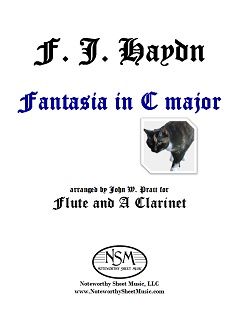 Fantasia in C major, by F. J. Haydn
Fantasia in C major, by F. J. HaydnArranged as a Duet for Flute and Clarinet by John W. Pratt
Flute Part, A Clarinet Part, and Mini-Score ― PDF $12.99
Fantasia in C major (Op.58; Hob. XVII:4) was written by Haydn in 1789 for the pianoforte. Based on a folk song about a farmer's wife chasing her cat, one can easily imagine in the music kittenish scampering, stealthy approaches, unexpected pounces, and mad chases with abrupt changes of direction. The style and playfulness of the piece lend themselves well to flute and clarinet. The transcription is able to capture the feel Haydn intended, with new coloring, while at the same time affording flutists and clarinetists the joy of experiencing the work first-hand. (adapted from JWP's foreword to the edition)
Flute part, 6 pages; Clarinet in A part, 6 pages; Mini-score in concert pitch, 6 pages; Total, 24 pages.
Preview -
Haydn - Trio, Hob. XV:18 - arr. Woodwind Quartet
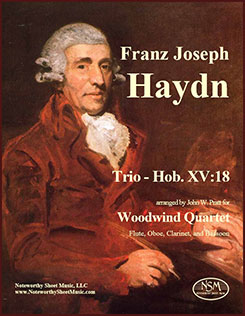 Trio, Hob. XV:18, by Franz Joseph Haydn
Trio, Hob. XV:18, by Franz Joseph Haydntransposed to B-flat major and arranged for Woodwind Quartet by John W. Pratt
Score and Parts for Flute, Oboe, B-flat Clarinet, and Bassoon; PDF $20.97
As noted in the arranger’s forward to the edition, the later piano trios of Franz Joseph Haydn (1732-1809) are superb music, but because they were written for excellent pianists and weak string players, they are dominated by the piano part. This imbalance among the parts actually makes the trios highly amenable to and effective in arrangement for woodwind quartet. Written after Haydn’s first visit to London, the Piano Trio in A major, Hob. XV:18, was first published in 1794. The first of its three movements, a flowing Allegro moderato, is unified by ingenious use of the three-note motif opening its cantabile main theme. The lovely middle Andante, in ABA form and 6/8 meter, features some luxurious ornamentation and proceeds attacca to the spirited and humorous Allegro finale. The resources of a woodwind quartet are well suited to the musical ideas of this trio, and the arrangement adapts Haydn’s piano, violin, and cello lines wonderfully to the range and sonority of the instruments used: flute, oboe, B-flat clarinet, and bassoon. This adaptation is facilitated by transposition from Haydn’s original key of A major to B-flat major. We provide parts plus a score in concert pitch.
Click to listen to computer-generated audio samples from the score; audio clips from movements I (m44.4 - m64.3), II (m0 - m4.5 & m49.6 - m54.5), and III (m36.2.2 - m48) are separated by brief pauses.
Score in concert pitch, 21 pages; Flute part, 8 pages; Oboe part, 6 pages; B♭-Clarinet part, 5 pages; Bassoon part, 5 pages; Total, 52 pages.
Preview -
Haydn - Trio, Hob. XV:25 ‘Gypsy’ - arr. Woodwind Quartet
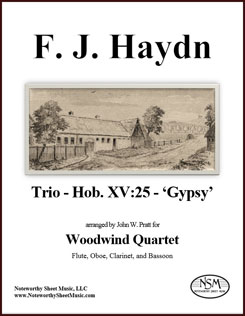 Trio, Hob. XV:25 ‘Gypsy’, by Franz Joseph Haydn
Trio, Hob. XV:25 ‘Gypsy’, by Franz Joseph Haydnarranged for Woodwind Quartet by John W. Pratt
Score and Parts for Flute, Oboe, B♭-Clarinet, and Bassoon; plus, an alternative A-Clarinet part; PDF $16.97
Short summary adapted by NSM from John W. Pratt’s foreword to the edition:The trios Hob. XV: 24-26 were, in Robbins Landon’s account (Haydn, Indiana, 1976), probably the last works Haydn delivered to his publishers before he left England in 1795. They were written for strong amateur pianists and weak string players, and although the string parts are essential for their effects on sonority, they are not terribly interesting. Such a scenario lends itself beautifully to arrangement of these piano trios for wind quartet.
Haydn labeled the finale of Hob. XV: 25 "in the Gypsies' style", and the trio became an enormous favorite. In the key of G, it opens with a particularly lovely slow movement having alternating minor and major variations. The third variation is in the relative minor (e), anticipating the key, E major, of the even slower, but subtle and melodically rich, second movement. This retardation heightens the effect of the famous finale.
We have provided alternative parts for clarinet in B-flat and in clarinet in A. Some players may wish to use the A-clarinet only in the second movement, for the sake of the friendlier key signature and perhaps also for sound, depending on the instrument.
Click to listen to computer-generated audio samples from the score; audio clips from movements I (m42-48, m72-78), II (m57-63), and III (168-190) are separated by brief pauses.
Score in concert pitch, 17 pages; Flute part, 6 pages; Oboe part, 4 pages; B♭-Clarinet part, 6 pages; Bassoon part, 4 pages; alternative part for A-Clarinet, 6 pages; Total, 56 pages.
Preview -
Hewitt - Trip to Nahant - Flute + Clarinet
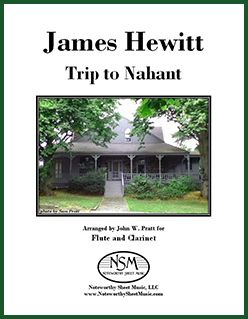 Trip to Nahant, by James Hewitt
Trip to Nahant, by James HewittArranged as a Duet for Flute and Clarinet by John W. Pratt
Flute Part, Bb Clarinet Part, alternate A Clarinet Part, and Score ― PDF $5.99
James Hewitt (1770-1827) moved from London to New York in 1792 and was active in both New York and Boston as a composer, arranger, music publisher, performer, teacher, and orchestra conductor. In Hewitt's time, Nahant was an island connected to the mainland by a sandbar submerged at high tide, now a causeway. It was a popular, cool place for day trips from Boston and later became a fashionable summer resort.
Hewitt's Trip to Nahant, a favorite Rondo (1811) was written for keyboard, and is typical of American music of the period. It is charming, light in texture and subject, and well suited to arrangement for flute and clarinet. (adapted from JWP's foreword to the edition) We provide parts for Flute and Clarinet in Bb, along with an alternative part for Clarinet in A and a Score in concert pitch.
Flute part, 2 pages; Bb Clarinet part, 2 pages; alternate A Clarinet part, 2 pages; Score, 4 pages; Total, 16 pages.
Preview -
Hoffmeister - Sonata in D minor - Flute and Clarinet
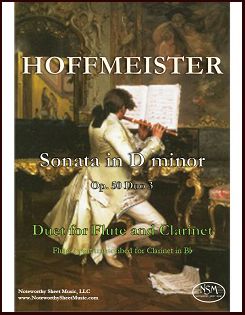 Sonata in D minor, Op.50, Duo 3, by Franz Anton Hoffmeister
Sonata in D minor, Op.50, Duo 3, by Franz Anton Hoffmeister
Duet transcribed for Flute and Bb Clarinet
Score and Parts, PDF $11.25
Noteworthy Sheet Music published an edition of the Sonata in D minor, Duo 3 from Hoffmeister's Trois Duos pour Deux Flûtes, Op.50, after being contacted by flutist Richard A. Evans. Years ago, Mr. Evans had located several editions of 18th and 19th century flute duets, long since out of print, at the Library of Congress. Finding them quite enjoyable to play, and believing them undeserving of their current obscurity, he and his music colleague Bronnie Stroud took the initiative of re-typesetting and editing the pieces using a modern music notation software program. Aware of the paucity of repertoire available for flute and clarinet duo, and realizing these pieces would work nicely for that instrument pair as well, he also transcribed the second flute parts for Bb clarinet. We at NSM agreed that these works should be made more readily available to present-day musicians and audiences, and we published them after making only minor stylistic and formatting revisions to Mr. Evans' scores and parts; the articulation and dynamic markings are those suggested by Mr. Evans.
Preview
Score, 15 pages; Flute part, 8 pages; Bb Clarinet part 8 pages; Total, 34 pages.
-
Lane - Danzas Mecánicas - Wind Quintet
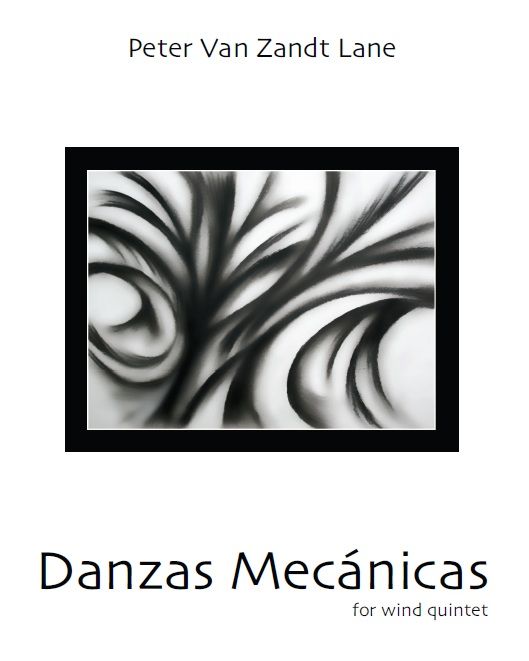 Danzas Mecánicas, by Peter Van Zandt Lane
Danzas Mecánicas, by Peter Van Zandt LaneContemporary Composition for Wind Quintet, PDF $30.00
Peter Van Zandt Lane is a Boston-based composer and bassoonist. His compositions have been performed across the United States, as well as in Europe and South America, by acclaimed musicians and ensembles such as The Cleveland Orchestra, SIGNAL, International Contemporary Ensemble, Dinosaur Annex, New York Virtuoso Singers, Triton Brass, Xanthos Ensemble, East Coast Composers Ensemble, EAR Duo, Quux Collective, and NotaRiotous. He has written for chamber ensemble, wind ensemble, orchestra, and choir, and often employs the use of electronics in his works.
Lane's Danzas Mecánicas - for woodwind quintet (2011) is an exciting 3-movement, 10-minute piece of fairly high difficulty scored for flute, oboe, clarinet, horn, and bassoon. A recording of the piece performed by the Solar Winds Quintet at Slosberg Hall, Brandeis University, in October, 2013 can be heard on YouTube.
Score, 26 pages; Parts, 49 pages; Total, 78 pages.
Preview -
Lane - Seven Rants - Wind Quintet & Piano
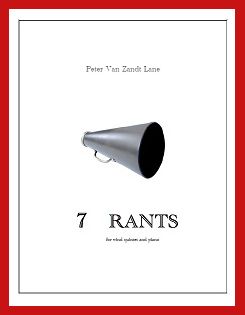 Seven Rants, by Peter Van Zandt Lane
Seven Rants, by Peter Van Zandt LaneContemporary Composition for Flute, Oboe, Clarinet, Horn, Bassoon, and Piano, PDF $0.00
Peter Van Zandt Lane was commissioned to compose this piece for the 67th Composers Conference and Chamber Music Workshop at Wellesley College, which took place in the summer of 2011. The annual Conference is a wonderful two-week event, which brings together prominent young composers, superb professional musicians, dedicated amateur chamber musicians, and enthusiastic listeners. The professional musicians premiere the composers' new works and also coach the amateur musicians in chamber ensembles. Concerts are free and open to the public. For more information on the program, please visit the Composers Conference website.
After the Conference each year, one of the composer fellows is selected to create a new work for the next year's chamber music workshop participants. That composer returns the following summer to coach two groups of players on the new composition, in preparation for performances in the Saturday evening concerts of Week I and Week II. Peter Van Zandt Lane's Seven Rants was an enormous success in 2011, absolutely loved by the players and received exceptionally well by the audience. Written for flute, oboe, clarinet, horn, bassoon, and piano, Seven Rants is a series of seven delightful and diverse movements. The first and last movements are strict palindromes. The five middle movements or "rants" are "mini-concertos", each highlighting a different wind instrument. Great fun to play, and highly accessible.
With permission from both the composer and the Wellesley Composers Conference and Chamber Music Center, Noteworthy Sheet Music is thrilled to offer our customers a free PDF download of Seven Rants by Peter Van Zandt Lane. And please check out more of this terrific young composer's work, including two other listings in the NSM catalog, Danzas Mecánicas and Transverse Fractures.
Score, 37 pages: Flute part, 10 pages; Oboe part, 9 pages; Clarinet part, 10 pages; Horn part, 9 pages; Bassoon part, 9 pages; Piano part, 15 pages; Total, 103 pages.
-
Loeffler - 4 Poèmes - Clarinet (Voice, Clarinet and Piano)
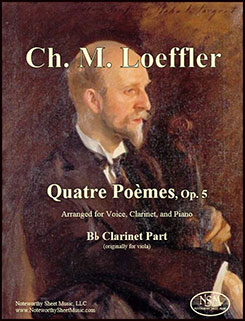 Quatre poèmes pour voix, alto et piano, by Charles Martin Loeffler
Quatre poèmes pour voix, alto et piano, by Charles Martin LoefflerViola part transcribed for Clarinet by C.A.Vater
Part for B-flat Clarinet; PDF $10.99
Noteworthy Sheet Music’s transcription of the viola part for Brahms’ Two Songs for Alto, Viola, and Piano, Op. 91 for clarinet quickly became one of our most popular editions, so we wanted to please our customers with another voice, clarinet, and piano option. We decided to create a clarinet version of the poems famously set to music by Charles Martin Loeffler (1861-1935). Quatre Poèmes pour Voix, Alto et Piano, Op. 5 was premiered by the Boston Symphony Orchestra with Loeffler himself on viola. In these four songs, Loeffler set to music one poem by Charles Baudelaire (“La cloche fêlée”) and three poems by Paul Verlaine (“Dansons la Gigue!”, “Le son du cor s’afflige vers les bois”, and “Sérénade”). Each of these songs has a unique character but Loeffler’s love of color variations and dense harmonies can be heard throughout the set.
We have taken care to adapt the viola part to the clarinet as conservatively as possible, and we think it works well. Obviously, there are places where we had to make modifications, and occasionally some difficult choices—for example where the viola has double stops, goes out of clarinet range, or uses harmonics or pizzicato. We encourage clarinetists who plan to perform this piece to listen to recordings of these songs with viola, and to consult the original viola part and score, available as free PDF downloads from imslp.org. Our edition includes only the transcribed clarinet part.B♭-Clarinet part, 10 pages; Total, 14 pages.
Preview
-
Massenet - On Dit! - trans. Clarinet, Voice and Piano
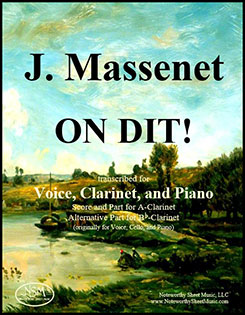 On Dit!, by Jules Massenet
On Dit!, by Jules MassenetTranscribed for Clarinet, Voice and Piano by C. A. Vater
Score for Clarinet, Voice and Piano; Alternative Parts for A-Clarinet and B-flat-Clarinet, PDF $8.99
Massenet’s composition On dit! is a musical setting of the eponymous poem by Jean Roux in which the poet ponders how the word “love” is commonly and inevitably associated with the sweetness and delights of spring. In addition to the vocal line and piano accompaniment, Massenet provided On dit! with a prominent part for cello. The cello line can be readily adapted for clarinet, creating a lovely and suitable new version of the piece for clarinet, voice, and piano. Our Noteworthy Sheet Music edition includes a score in concert pitch, as well as individual parts for either A-clarinet or B-flat-clarinet transcribed from the original cello part. Clarinetists in possession of both A and B-flat instruments may develop a personal preference for playing this piece on one instrument over the other, based on tone quality, complementarity with a particular singer’s sound, etc.
Score, 5 pages; A-Clarinet Part, 2 pages; B-flat-Clarinet Part, 2 pages; Total, 16 pages.
Preview -
Mendelssohn - Concert Piece No.1 - Two Winds and Piano
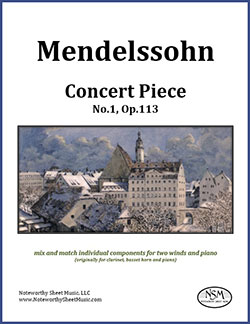 Concert Piece No.1, Op.113, by Felix Mendelssohn
Concert Piece No.1, Op.113, by Felix MendelssohnTranscribed for Various Wind Instruments and Piano by John W. Pratt
(originally for Clarinet, Basset Horn, and Piano)
Individual Primo parts for Clarinet, Flute, or Oboe, PDFs $6.99 each
Individual Secondo parts for Bassoon, Clarinet, or English Horn, PDFs $6.99 each
Piano Score, with original Clarinet and Basset Horn lines in concert pitch, PDF $6.99
The following is excerpted from John Pratt's © foreword:
"In 1833, Felix Mendelssohn (1809-1847) wrote two Concert Pieces for Clarinet, Basset Horn, and Piano, op. 113 and op. 114, as show-pieces for the famous clarinetist Heinrich Bärmann (1784-1847) to play with his up-and-coming son Karl (1811-1885) on the basset horn. // Mendelssohn's two Concert Pieces are very suitable for transcription, even aside from the rarity of the basset horn today. We provide, as well as the original clarinet part, transcriptions of it for flute and oboe. Transcriptions of the basset horn part are provided for bassoon, clarinet, and English horn. These primo and secondo parts can be mixed and matched at will. For the score, we use Mendelssohn's instruments rather than some other arbitrary pair. This enables anyone interested to check any transcribed part against the original. The score gives the parts in concert pitch, because a transposition would apply to only one of the possible winds, and because the pianist can then easily play any part at original pitch."Please note that PDFs of the original score and clarinet-primo part are available free of charge in the public domain (see the listing of this work on IMSLP.org), and our transcribed primo and secondo wind parts can readily be used with the original score. Therefore, you should purchase our original instrument Score or Clarinet-primo part only if you would like measure numbers or Mr. Pratt's score (for piano with clarinet and basset horn) in concert pitch.
- Piano Score with Clarinet and Basset Horn lines in concert pitch, 8 pages; Total, 10 pages (note that the original score is freely available on IMSLP.org)
- Clarinet in B-flat, primo part, 4 pages; Total, 6 pages (note that the original clarinet part is freely available on IMSLP.org)
- Flute, transcribed primo part, 4 pages; Total, 6 pages
- Oboe, transcribed primo part, 4 pages; Total, 6 pages
- Bassoon, transcribed secondo part, 4 pages; Total, 6 pages
- Clarinet in B-flat, transcribed secondo part, 4 pages; Total, 6 pages
- English Horn, transcribed secondo part, 4 pages; Total, 6 pages
-
Mendelssohn - Concert Piece No.2 - Two Winds (and Piano)
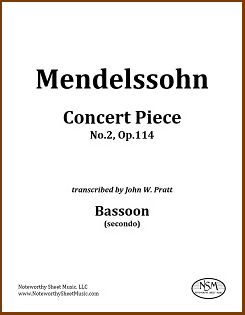 Concert Piece No.2, Op.114, by Felix Mendelssohn
Concert Piece No.2, Op.114, by Felix MendelssohnTranscribed for Various Wind Instruments (and piano) by John W. Pratt
(originally for Clarinet, Basset Horn, and Piano)
Primo parts for Clarinet, Flute, or Oboe, PDFs $5.99 each
Secondo parts for Bassoon, Clarinet, or English Horn, PDFs $5.99 each
The following is excerpted from John Pratt's © foreword:
In 1833, Felix Mendelssohn (1809-1847) wrote two Concert Pieces for Clarinet, Basset Horn, and Piano, op. 113 and op. 114, as show-pieces for the famous clarinetist Heinrich Bärmann (1784-1847) to play with his up-and-coming son Karl (1811-1885) on the basset horn. // These works are very suitable for transcription, even aside from the rarity of the basset horn today. We provide, as well as the original clarinet part, transcriptions of it for flute and oboe. Transcriptions of the basset horn part are provided for bassoon, clarinet, and English horn. These primo and secondo parts can be mixed and matched at will. // Since a good quality PDF of the original piano score with excellent page turns is freely available in the public domain (see IMSLP.org), we have not provided a score here; our transcribed primo and secondo wind parts can readily be used with the original score.
Each wind part is 4 pages of music; 6 pages total.
Primo parts for Flute, Clarinet in B-flat (note that the original primo clarinet part is freely available on IMSLP.org), or Oboe.
Secondo parts for Clarinet in B-flat, Bassoon, or English Horn. Preview Bassoon II part
-
Mozart - Sinfonia Concertante - Fl/Cl/Pf
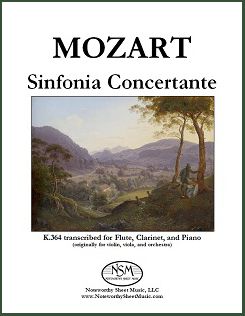 Sinfonia Concertante, K.364, by Wolfgang Amadeus Mozart
Sinfonia Concertante, K.364, by Wolfgang Amadeus MozartTranscribed for Flute, Clarinet, and Piano by John W. Pratt
(originally for Violin, Viola, and Orchestra)
Piano Score, Flute & Clarinet Parts, PDF $17.99
Excerpted from the Foreword by J. W. Pratt: "The idea that every piece, especially a major one, can be satisfactorily transcribed for whatever instruments one would like is one I firmly reject. However, a trio arrangement of this Sinfonia Concertante for flute, clarinet, and piano can, I believe, capture and present in a new light many of the wonders of this great work, even the wonders of its sonorities..... In the arrangement here, the flute and clarinet almost always play either a solo part or an orchestral part with only octave changes..... For the piano, on the other hand, straightforward orchestral reduction is often ineffective and unsatisfying, and that would certainly be true here, even with the flute and clarinet taking some wind parts. I have attempted instead to find natural piano "orchestrations" as alternatives to Mozart's orchestral layouts, especially where the full orchestra is playing..... Such effects, often heightened on returns, are better suited to the piano's capabilities and its role as a member of a trio than a straightforward reduction would be..... The music available for flute, clarinet, and piano includes surprisingly few major works. The purpose of our arrangement is to add a significant piece to this repertoire and to enable players and listeners to enjoy Mozart's magnificent Sinfonia Concertante in a new way."
Score, 41 pages; Flute part, 18 pages; Clarinet part, 17 pages; Total, 82 pages.
Preview -
Mozart – Sonata in E minor – Clarinet (and Piano)
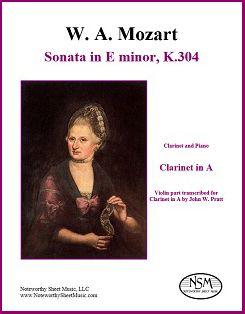 Sonata in E minor, K.304, by W. A. Mozart
Sonata in E minor, K.304, by W. A. MozartTranscribed for Clarinet (and Piano) by John W. Pratt
Clarinet in A Part, PDF $5.99
Mozart's second group of violin sonatas, the seven "Mannheim" sonatas of 1778, were begun in Mannheim where the composer also worked on a flute commission. The violin parts rarely make significant use of double stops and are in general well suited to a wind instrument. Mozart's works in minor keys are rare and special: consider the G-minor quintet and Symphony No. 40. The K.304 sonata is his only work in E minor and it is mysteriously compelling in its simplicity. Mr. Pratt has created an excellent transcription of the Sonata in E minor, K.304 for A-clarinet. K.304 was written the same summer that Mozart's mother died, an association often pointed to and the inspiration for our cover image selection.Note that Mr. Pratt's transcription offers the advantage of being in the original key, and that we provide the A-clarinet part only. The clarinet part works perfectly with the piano part in Mozart's score for piano and violin, which is in the public domain and readily available on imslp.org, free of charge.
For additional information about the seven Mozart Mannheim sonatas and Mr. Pratt's previous transcriptions of them for alto flute, please read his article Mozart's Mannheim Sonatas, which was originally published by Flute Focus and subsequently republished by NSM on our Resources – Reviews and Articles page.
Preview
Clarinet part, 5 pages; Total, 8 pages. -
Schubert - Auf dem Strom - Vo/Cl/Pf
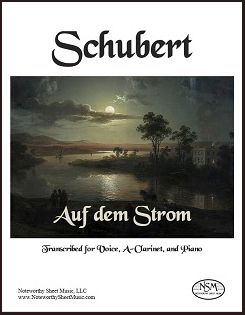 Auf dem Strom, Op.119, by Franz Schubert
Auf dem Strom, Op.119, by Franz SchubertObbligato transcribed for A-Clarinet by C. A. Vater
Piano Score and Parts for Voice and A-Clarinet, PDF $9.50
The great Austrian composer Franz Peter Schubert (1797-1828) was a master at creating extremely beautiful, melodic, emotional lieder. His song Auf dem Strom (On the River) provided a musical setting for the text of the eponymous poem written by the German poet and music critic Ludwig Rellstab. The lyrics tell the story of a sad parting, of the yearning and loneliness that sets in as the narrator bids farewell to a loved one on shore, while his river journey carries him away towards the sea. The premier performance of Auf dem Strom took place in Schubert’s 1828 public concert, during which the obbligato part was played by Josef Lewy on horn, the instrument for which the obbligato was written and which undoubtedly can provide an appropriately mournful, sentimental character to the piece. However, an alternate obbligato version for cello was also published. Now, with all respect, we provide an A-clarinet version of the obbligato, in expectation that clarinetists will appreciate this addition to the voice/clarinet/piano repertoire. We believe that a well-played clarinet can aptly contribute a suitably complex, dolorous essence and tone that will adequately do justice to this highly romantic lied by Schubert. Schubert himself created one of his most wonderful and popular works, Der Hirt auf dem Felsen, for clarinet obbligato, and we hope he would welcome our adaptation of Auf dem Strom for A-clarinet.
Score, 19 pages; Voice part, 4 pages; A-Clarinet part, 4 pages; Total, 32 pages.
Preview -
Schubert – Der Hirt auf dem Felsen – Alto Flute (voice trans.)
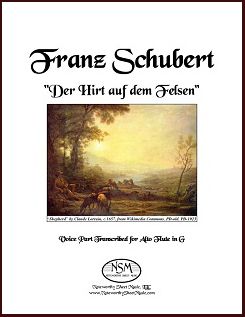 Der Hirt auf dem Felsen, Op.129, by F. Schubert
Der Hirt auf dem Felsen, Op.129, by F. Schubert Voice Part Transcribed for Alto Flute in G by Carol A. Vater
Alto Flute Part, PDF $5.99
NSM published Peter H. Bloom's alto flute transcription of the clarinet obbligato from Schubert's Shepherd on the Rock in 2012. Please find information about that publication in our article for that edition. Later we realized that the voice part, which I have performed on flute in a flute/clarinet/piano group, would work much better when played on alto flute. So we created a transcription of the vocal part for alto flute. This alto flute transcription is to be played in an entirely instrumental version of Der Hirt auf dem Felsen for alto flute, clarinet (or alto flute), and piano, which as noted by Mr. Bloom, is "an ideal didactical vehicle for coaching the developing flutist in the art of rhetorical performance as well as a splendid concert/recital piece." Our alto flute transcription of the voice part is a simple transposition requiring no octave changes; the part falls naturally and beautifully within the alto flute range. The clarinet part and piano score are freely available at IMSLP.org.
Preview -
Schumann, Clara – Sechs Lieder - trans. for Clarinet (and piano)
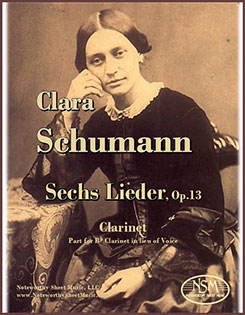 Sechs Lieder, by Clara Schumann
Sechs Lieder, by Clara SchumannTranscribed for Clarinet by C. A. Vater
Part for B-flat Clarinet (in lieu of voice); PDF $5.99
In her Sechs Lieder, Op. 13, Clara Schumann set to music six German poems—two written by Heinrich Heine (Ich stand in dunklen Träumen and Sie liebten sich beide), three by Emanuel Geibel (Liebeszauber, Der Mond kommt still gegangen, and Die stille Lotosblume) and one by Friedrich Rückert (Ich hab’ in deinem Auge). Many of Clara Schumann’s songs were composed as gifts for her beloved husband Robert; they are romantic, melodic and highly expressive, and the Sechs Lieder of Op. 13 appropriately convey the broad array of intense emotions portrayed in the poetry that inspired them. These songs, which are absolutely charming, are nicely adaptable for a solo instrument in lieu of voice. They have been transcribed previously for violin or cello, and likely other instruments as well, but are particularly lovely when played on either alto flute or clarinet, instruments for which the voice line falls completely in range. Our Noteworthy Sheet Music editions of Op. 13 for alto flute or clarinet do not include re-notated versions of the score, since a high-quality PDF of the original piano and voice score is available free of charge in the public domain, and that piano accompaniment works perfectly well with our instrumental transcriptions of the voice line. The score we used when creating our parts may be downloaded from the IMSLP website. For NSM’s alto flute transcription of the Sechs Lieder voice line, please click the link.
B-flat Clarinet Part, 4 pages; Total, 6 pages.
Preview
-
Scriabin - Romance - Transcribed for Clarinet, Flute, or Alto Flute
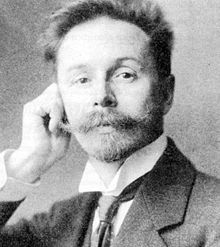 Romance, by Alexander Scriabin
Romance, by Alexander ScriabinTranscribed for Clarinet or Flute or Alto Flute (and Piano) by J. W. Pratt
Parts, PDF $0.00
Alexander Scriabin (1872-1915), the mystic Russian composer with music to match, wrote nine mind-bending orchestral works and myriad mostly miniature piano pieces. He began as a "Russian Chopin" and ended planning a week-long "Mysterium" to be performed in the Himalayas using "an orchestra, a large mixed choir, an instrument with visual effects, dancers, a procession, incense, and... mists and lights" (Wikipedia).
The Romance of 1890, his only chamber work except one variation for string quartet, is nearer the Chopin end of that spectrum, though the piano part adds harmonic and rhythmic complexities not evident from the solo part alone.
- John W. Pratt, Jan. 19, 2016
Please click on the links to download your free PDFs:
Transcription for clarinet required no changes of pitch. Scriabin - Romance - Clarinet
The transcription for flute is raised an octave, except the last five measures. Scriabin - Romance - Flute
The transcription for alto flute raises MM21-24 and MM36-48 an octave. Scriabin - Romance - Alto Flute
The piano score is freely available on IMSLP.org.
Scriabin image courtesy of Wikimedia.org, PD-old.
-
Valerius/Kremser/Pratt - We Gather Together - arr. WW5
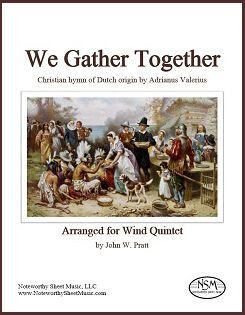 We Gather Together, by Adrianus Valerius
We Gather Together, by Adrianus ValeriusArranged for Woodwind Quintet by John W. Pratt
Score and Parts for Flute, Oboe, Bb Clarinet, F Horn, and Bassoon; PDF $5.99Wilt heden nu treden, nowadays more commonly known as We Gather Together, is a Christian hymn of Dutch origin composed by Adrianus Valerius and first published in 1626 (imslp.org); it was later harmonized by Eduard Kremser (en.wikipedia.org). In the United States, We Gather Together is the most popular song traditionally associated with the Thanksgiving holiday. John Pratt has created an arrangement of We Gather Together for woodwind quintet that lends new excitement and interesting harmonies to this old favorite. In his family, the tradition goes back as far as John Pratt (b. 1931) can remember, and when it fell to him to play all three stanzas at his family's annual gathering, he got interested in livening it up. The opportunistic half-step modulations introduced to help amateur voices warm up also brighten successive stanzas for winds. Our Noteworthy Sheet Music edition includes a score in concert pitch, as well as parts for flute, oboe, Bb clarinet, horn in F, and bassoon.
To listen to a computer-generated audio file of the WW5 arrangement, click the link.
Of course, the piece will sound much better live on real instruments.
Note that for this publication, the parts should be printed one-sided since they are only one page each and we have not inserted blank filler pages.
Score, 3 pages; Parts for Flute, Oboe, Bb Clarinet, F Horn, and Bassoon, 1 page each; Total, 10 pages.
Preview